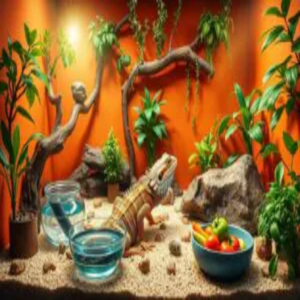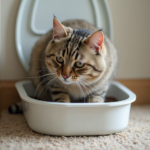What does it take to create a happy and healthy environment for your bearded dragon? What bearded dragon secrets can you apply to ensure your pet thrives? You’re about to embark on an exciting journey as a responsible pet owner. You’ll learn how to provide the best possible life for your bearded dragon through proper care.
Your bearded dragon can become a beloved and loyal companion with the right care and attention. They can live a long and healthy life as a happy bearded dragon.
As you explore bearded dragon care, you’ll learn how to create a nurturing environment. This environment fosters growth and well-being, unlocking the secrets to a happy pet.
Key Takeaways
- Understanding the basics of bearded dragon care is crucial for a happy and healthy pet
- Creating a suitable environment is essential for your bearded dragon’s growth and well-being
- Proper bearded dragon care involves providing a balanced diet and adequate lighting
- Regular maintenance and cleaning are vital for your bearded dragon’s health
- Staying informed about bearded dragon secrets and best practices can help you become a confident and successful pet owner
- By following the right bearded dragon care guidelines, you can help your pet live a long and healthy life as a healthy bearded dragon
- Make Your Bearded Dragon Thrive – Get Instant Access to the Secrets!
Getting Started with Bearded Dragon Care
Starting your journey as a bearded dragon owner is exciting. A good bearded dragon manual will help you understand the basics. It ensures you care for your pet in the best way possible. With the right guide, you’ll create a happy and healthy home for your bearded dragon.
First, learn about bearded dragon health tips. This includes a balanced diet, the right enclosure, and proper heating and lighting. A well-planned setup prevents health issues and helps your bearded dragon live a long, healthy life. Following a trusted manual and guide helps you spot and prevent health risks.
Essential Equipment Checklist
- Suitable enclosure
- Heating and lighting equipment
- Balanced diet and supplements
- Hiding places and climbing structures
When picking your first bearded dragon, think about age, size, and temperament. A good breeder or pet store will give you a healthy dragon. This sets you up for success as a new owner. By focusing on your bearded dragon’s health, you’ll build a strong bond and a lifelong friendship.
Creating the Perfect Habitat Environment
As a bearded dragon owner, setting up a good habitat is key for your pet’s health. A well-designed habitat is crucial for your pet’s comfort and happiness. The enclosure is the heart of a thriving habitat. It should be big enough for your bearded dragon to move, climb, and bask.
Some important things to think about for a great habitat include:
- Providing a temperature range of 75-90°F (24-32°C) with a basking spot of 95-100°F (35-38°C)
- Ensuring proper ventilation to maintain humidity levels and prevent respiratory problems
- Choosing a suitable substrate, such as calcium-based sand or reptile carpet, that is easy to clean and won’t cause respiratory issues
- Adding decorations, such as rocks, plants, and branches, to create a stimulating environment and provide hiding places
A good reptile care guide will suggest a habitat setup with a UVB light. This light is important for calcium metabolism and preventing bone disease. By following these tips, you can ensure your bearded dragon stays healthy and happy.
Creating a great habitat is what makes a bearded dragon happy and healthy. By putting effort into your pet’s home, you’ll get a loving and thriving companion.
| Enclosure Size | Temperature Range | Humidity Level |
|---|---|---|
| 20-30 gallons | 75-90°F (24-32°C) | 30-50% |
Temperature and Lighting Requirements
To keep your bearded dragon happy, you need the right temperature and lighting. They like a warm spot of 75-90°F (24-32°C) and a basking area of 95-100°F (35-38°C). Use heat lamps and UVB lighting to get this.
Good lighting helps your bearded dragon eat well and stay healthy. UVB lighting is key for calcium and preventing bone disease. Choose from fluorescent, LED, and mercury vapor lamps. Remember to change UVB lights every 6-8 months because they lose strength over time.
Stop Guessing! Unlock Expert Tips for a Healthy, Happy Bearded Dragon – Click Here!
Best UVB Lighting Options
- Fluorescent lamps: Provide a broad spectrum of UVB light
- LED lamps: Energy-efficient and long-lasting
- Mercury vapor lamps: Intense UVB output, but may require a separate ballast
Follow these tips for temperature and lighting to make your bearded dragon’s home comfy and fun. Learning about bearded dragon feeding and lighting needs is key to their health and happiness.
| Lighting Type | UVB Output | Lifespan |
|---|---|---|
| Fluorescent | 10-12% UVB | 6-8 months |
| LED | 12-15% UVB | 12-18 months |
| Mercury Vapor | 20-25% UVB | 6-12 months |
Nutritional Needs and Feeding Schedule
As a bearded dragon enthusiast, it’s key to give your pet a balanced diet. With expert advice, you can make a feeding schedule that fits your bearded dragon’s needs. A good diet includes live food, vegetables, and fruits.
Live foods like crickets, mealworms, and superworms are great for your bearded dragon. Add veggies like kale, collard greens, and carrots to their meals. Fruits like berries, melons, and apples are good treats sometimes. Knowing your bearded dragon’s diet needs is crucial for their health.
- Offer a variety of live food options to ensure a balanced diet
- Include a mix of vegetables and fruits in their diet
- Research and understand the specific dietary needs of your bearded dragon
- Consult with a veterinarian or experienced breeder for expert bearded dragon advice
| Food Type | Frequency | Portion Size |
|---|---|---|
| Live Food | Daily | 1-2 cups |
| Vegetables | Daily | 1/2 cup |
| Fruits | Occasional | 1/4 cup |
By following these tips and getting expert advice, you can give your bearded dragon a healthy diet. This ensures they live a happy and healthy life.
Essential Health Monitoring Tips
As a bearded dragon owner, it’s key to watch your pet’s health closely. A good care manual will guide you to keep your bearded dragon healthy and joyful. By following these tips, you can spot health problems early and prevent them from getting worse.
Some important health monitoring tips include:
- Look for signs of illness like being tired, not wanting to eat, or changes in stool or urine
- Check your bearded dragon’s skin and scales for injuries or infections
- Make sure the temperature and humidity levels are right for your pet
A good care manual will also stress the need for regular vet visits. These visits can catch health issues early and give you tips on caring for your bearded dragon. By following these steps and staying alert, you can help your bearded dragon live a long, healthy life.
Remember, a healthy bearded dragon is a happy one. By focusing on your pet’s health and happiness, you can create a strong bond. This makes being a bearded dragon owner rewarding and fulfilling.
| Health Issue | Symptoms | Preventive Measures |
|---|---|---|
| Metabolic Bone Disease | Softening of bones, lethargy, loss of appetite | Provide a balanced diet, ensure adequate UVB lighting, and maintain proper temperature and humidity levels |
| Respiratory Infections | Coughing, wheezing, difficulty breathing | Keep your bearded dragon’s enclosure clean, provide a balanced diet, and avoid exposing your pet to extreme temperatures or humidity levels |
Substrate and Decoration Selection
Choosing the right substrate and decorations for your bearded dragon’s home is key. A well-designed space helps your pet feel comfortable and happy. It’s important to pick a habitat that meets your pet’s needs. A good guide will tell you to avoid loose substrates that can harm your pet’s breathing.
For a clean and healthy home, the right substrate is crucial. Options like reptile carpet, paper towels, or indoor/outdoor carpeting are safe and easy to clean. Adding rocks, plants, and climbing structures can make the space more interesting for your pet.
Discover the Secrets to Raising a Thriving Bearded Dragon – Get Your Guide Now
Safe Substrate Options
- Reptile carpet
- Paper towels
- Indoor/outdoor carpeting
Recommended Climbing Structures
Climbing structures are vital for your bearded dragon’s health and happiness. You can use rocks, branches, or commercial structures to make the space varied. A good guide will suggest changing decorations often to keep your pet engaged.
Hide Box Considerations
Hide boxes are essential for your bearded dragon’s safety and comfort. You can use commercial hide boxes or make your own from cardboard or plants. A good guide will advise placing hide boxes in quiet spots to reduce stress.
Daily Maintenance and Cleaning Routines
As a bearded dragon owner, you know how vital a clean environment is for your pet. Daily cleaning routines are key to stopping disease spread and keeping your bearded dragon healthy. Training your bearded dragon also strengthens your bond.
Setting up a daily cleaning schedule is important. It helps keep your bearded dragon’s home clean and safe. Tasks include removing waste, cleaning food and water dishes, and disinfecting surfaces. Regular cleaning stops bacteria buildup and keeps your pet healthy.
Training your bearded dragon is also crucial for a clean environment. Teaching them basic commands and good behavior reduces accidents and messes. This training can help them use a specific area for waste or stay out of certain spots.
- Remove waste and clean the enclosure daily
- Clean food and water dishes regularly
- Disinfect surfaces to prevent the spread of diseases
- Train your bearded dragon to follow basic commands and behave well
By following these tips and setting up a cleaning routine, you can keep your bearded dragon happy and healthy. Always put your pet’s health first and seek advice if needed.
Transform Your Bearded Dragon’s Life – Download the Ultimate Manual Today!
Common Health Issues and Solutions
As a bearded dragon owner, knowing common health issues is key. Proper care is vital to keep your pet healthy. A balanced diet, good lighting, and a clean space are essential.
Bearded dragons can face issues like metabolic bone disease, respiratory infections, and parasites. Look for changes in appetite, lethargy, or breathing trouble. Regular vet visits can catch problems early.
Identifying Signs of Illness
Watching your bearded dragon’s behavior and health is crucial. Notice changes in appetite, stool, or urination. Also, watch for stress signs like pacing or hiding.
Preventive Care Measures
To avoid health problems, ensure good air flow and a temperature range. Feed a balanced diet with veggies, fruits, and proteins. Clean the enclosure and change the water often to stop bacteria.
When to Visit a Veterinarian
If you see illness or stress signs, see a vet who knows bearded dragons. They can guide you on treatment and care plans.
By following these tips, you can keep your bearded dragon healthy and happy. A well-cared-for dragon brings joy and a rewarding bond.
Handling and Socialization Techniques
Understanding handling and socialization is key in bearded dragon care. It helps build a strong bond with your pet. The bearded dragon secrets include gentle and patient interaction. This makes your pet comfortable with you.
A good bearded dragon manual stresses the importance of a calm environment. Choose a quiet spot without distractions. Start with short handling sessions and gradually increase time as your pet gets used to it.

- Moving slowly and deliberately to avoid startling your pet
- Supporting the body and tail to prevent injury
- Allowing your bearded dragon to retreat to a safe space if it feels overwhelmed
By following these tips, you can build a strong bond with your pet. Always check a reliable bearded dragon manual for specific care advice.
Take the First Step Toward Bearded Dragon Mastery – Get Your Copy Now!
Advanced Bearded Dragon Care Strategies
As you care for your bearded dragon, it’s key to use advanced strategies. These help meet their special needs. An ultimate care guide and health tips are essential for a happy pet.
For breeding, a good environment is crucial. You need a big enclosure with the right temperature and humidity. Also, think about genetic diversity for healthy babies. Seasonal changes affect your dragon’s health, so adjust their care accordingly.
- Provide a varied diet with live food and supplements.
- Make sure there’s a temperature range for your dragon to control its body heat.
- Keep humidity levels right to avoid breathing problems.
By using these advanced care tips and staying current with health advice, you can make a great home for your pet.
Revolutionize Your Bearded Dragon Care Routine – Start Here!
Conclusion: Your Journey to Becoming a Successful Bearded Dragon Owner
As you finish this detailed reptile care guide, you have all the key info to keep your bearded dragon happy and healthy. Setting up the right habitat and following good feeding tips will help you bond with your pet. You’re on the path to a fulfilling experience with your scaly friend.
Remember, caring for a bearded dragon is a big responsibility but also very rewarding. Always keep an eye on your pet’s health and seek vet advice if needed. With this guide’s help, you’ll face the ups and downs of owning a bearded dragon with confidence.
Enjoy your bearded dragon’s unique personality and feel proud of giving them the best care. Your adventure as a bearded dragon owner is starting, and the joy of seeing your pet flourish is priceless. Happy dragon keeping!





